CHALLENGE OF THE WEEK, MONTH, YEAR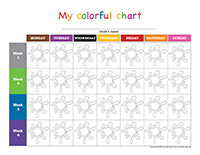
Problem-solving rainbow
(Open problem solving rainbow) Print, laminate, and glue on a piece of cardboard or the wall. Sit down with your group to present the problem-solving rainbow. Explain each illustration on the rainbow. The illustrations represent the steps that can help children resolve conflicts with their peers or soothe their own frustrations. Reserve a corner of the daycare for problem solving. Set up a table with two chairs, small rugs, or cushions. If you prefer, simply use colored tape to define the space. Make sure the problem-solving rainbow is displayed for all to see. Make it clear that from now on, whenever there is a conflict between friends, they are to go to the problem-solving corner to discuss it step by step. When they feel they have resolved the problem, they must call on you, their daycare worker, and explain the solution they have found to verify that it is in everyone's best interest.
My colorful chart
(Open my colorful chart) Print for each child. Use this chart daily to encourage children to learn to recognize colors. Invite them to color a box every time they learn to identify a new color. At the end of the week, use the charts to review the names of the colors you have explored.
CIRCLE TIME
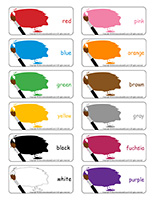
Animated discussion-Colors
(Open word flashcards-Colors) Print and laminate the word flashcards. Use them to spark a conversation with your group. Ask children questions pertaining to the theme. Add to your discussion by presenting a variety of colorful items.
What is your favorite color?
Which color do you like the least?
What color is your hair?
What color are your eyes?
Make your own “speaker” hat
You can simply use a straw hat that you already have and press colorful shapes all over it. Hide several colorful illustrations throughout your daycare and encourage children to search for them and set them in a basket in the center of your circle time area. Use the items to spark a conversation about the theme. Use your “speaker” hat to indicate whose turn it is to speak.
Rainbow letter
We suggest an imaginary game to begin each day. (Open rainbow letter) Print the rainbow letter. Prepare a colorful envelope. Place the envelope in an easy to find place in the daycare. During circle time, have the children find the letter and read portions of the letter each day. Follow the daily instructions.
AREA SETUP
Thematic poster-Colors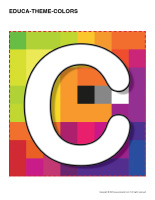
(Open thematic poster-Colors) Print, laminate, and decorate the walls of your daycare with all kinds of posters.
Educa-theme – Colors
(Open educa-theme-Colors) Print, cut out, and laminate. Use the items to decorate the walls of your daycare and set the mood for the theme.
Educa-decorate – Colors
(Ouvrir educa-decorate – Colors) Print, cut out, and laminate. Decorate the walls of your daycare and hang decorations from the ceiling to set the mood for the theme.
Stickers-Colors
(Open stickers-Colors) Print the illustrations on adhesive paper and use them to create a set of original stickers.
Educa-decorate – Rainbows
(Ouvrir educa-decorate – Rainbows) Print, cut out, and laminate. Decorate the walls of your daycare and hang decorations from the ceiling to set the mood for the theme.
Thematic activity planning-Colors
(Open thematic activity planning-Colors) Print and laminate. Write your planned activities directly on the document and display it.
Hang multicolored miniature Christmas lights, glue pictures of various colors on the ceiling and on your daycare walls, install garlands and multicolored balloons. Paint the windows with window paints. Use old gift bags of different colors, cut out the designs, laminate them and place them on the floor in the nursery for babies to explore. You can do the same in other corners also.
VARIOUS WORKSHOPS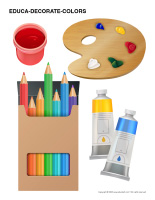
Have fun with these great workshop ideas provided by Caroline Allard.
Building blocks:
- Instead of sorting blocks according to kind (wooden, LEGO, etc.), sort them in bins according to color.
- Provide square pieces of felt and encourage children to create various constructions.
- Sort figurines, small cars, or any small toys by color.
Arts & Crafts:
- This is the perfect time to explore paint and initiate children to different color combinations. Red and yellow = orange, Blue and red = purple, Yellow and blue = green, and what happens when we add white to primary colors or if we mix everything together?
- Construction paper and all kinds of bright-colored paper to cut, draw on, and promote creativity per children's moods and inspiration.
- Finger paints for easy color mixing.
- Markers with different tips (large, fine, bevel-edged, etc.) to explore colors even further.
- Color by number pages.
- Various coloring pages.
Role Play: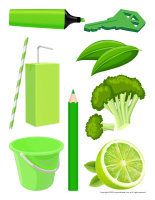
- Transform your corner to represent a "paint shop". Children become painters. Provide paint samples, paintbrushes, paint rollers, painting caps, and mixing sticks. Ask parents to bring in home décor magazines. Add old shirts that have paint stains on them.
- Create an artist corner with an easel and a paint palette. A few sheets of paper and there you have it!
Manipulation:
- Memory game with colors.
- Modeling clay. Use primary colors and for once, allow children to mix colors to explore color combinations. Make your own modeling clay. You will limit the cost and children will have fun for hours!
- Association game with pictures of various objects and colored cards (ex. A picture of an orange and the orange-colored card, a picture of a banana and the yellow card...).
- Different sorting games using colors (with objects in the daycare).
- Colored cellophane paper allows children to appreciate colors. It can be attached to the end of toilet paper rolls to create special binoculars.
- Lite-Brite or mosaic games are high in color.
Reading/Relaxation:
- Books about shapes and colors or simply books children choose because of the appealing colors that are part of the illustrations.
Music/Motor skills:
- "Twister" style game which can be made and played with original variations.
- Red light, green light game.
Sensory bins:
- Water table: add a few drops of food coloring.
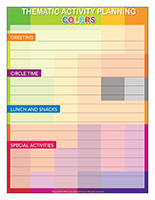
- Rocks: create a low-cost multicolored rock bin with aquarium pebbles.
- "Froot Loops" cereal.
Science:
- All science experiments involving colors can be explored (color explosion in milk, the flower that changes color when food coloring is added to the water, color combinations with paint, a cake frosted with colored frosting, etc.).
ACTIVITY SHEET
(Open activity sheet) Print, laminate and add to the writing corner.
PICTURE GAME
The pictures may be used as a memory game or to spark a conversation with the group. There are different formats to choose from. Use the pictures to decorate the daycare or a specific thematic corner. (Open picture game-Colors) Print, laminate and store in a "Ziploc" bag or in your thematic bins.
WORD FLASHCARDS
The flashcards may be used during circle time or to decorate your daycare. (Open word flashcards - colors) (Open giant word flashcards-Colors) Red, blue, green, yellow, black, white, pink, orange, brown, gray, fuchsia, purple
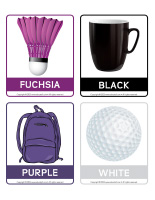
Scene-Colors
(Open scene-Colors) Print, laminate, and cut out the items on the second page. Children use the pieces to decorate the scene.
Positive reinforcement – Colors
(Open positive reinforcement-Colors) Print. Use the model to cut several multicolored leaves out of felt or Fun Foam sheets. Display a tree trunk on the wall for each child. Every time a child brushes his teeth or washes his hands, for example, encourage him to press a leaf on his tree. Once a child’s tree is complete, you can reward him. You may also simply choose to encourage children to create a colorful mural to decorate your daycare.
PHYSICAL ACTIVITY AND MOTOR SKILLS
Modeling dough activity placemats – Colors
(Open modeling dough activity placemats – Colors) Print and laminate. Let children pick a placemat and provide modeling dough. Encourage them to use the dough to fill or reproduce the shapes that are on their placemat.
Playing cards-Colors
(Open playing cards-Colors) Print and laminate. Give each child the same number of cards. They can take turns hiding them throughout the daycare. Each child then tries to find as many cards as possible.
Ball pit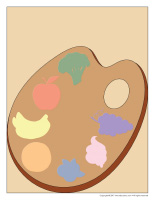
Fill a kiddie pool with colorful balls. Let children play in your homemade ball pit. Encourage them to name the colors as they toss the balls.
Color tree
Use electrical tape to draw a simple tree outline on the floor. Provide colorful bean bags. Encourage children to stand a few feet from the tree and toss the bean bags on the branches to represent leaves.
Bowling game-Colors
(Open bowling game-Colors) Print on adhesive paper and press the stickers on empty plastic bottles to create an original bowling game. Arrange the bottles on the floor and invite children to roll a tennis ball towards them. Give each child three tries. The goal is to tip all the bowling pins over.
Pyramid – Colors
(Open large stickers-Colors) Print on adhesive paper and use the stickers to create a variety of games. You can press the stickers on empty metal cans and then invite children to build a pyramid. Children can then try to make the pyramid fall down by tossing a frisbee towards it. Give each child 3 tries.
Fine motor skills – Crumpled tissue paper shapes
(Open shapes-Colors) Print for each child. Have children tear small pieces of tissue paper and crumple them to form tiny balls. They can pick a shape and apply white glue inside the lines before pressing the crumpled balls of tissue paper all over it. Use children’s creations to decorate your daycare for the duration of the theme.
Color board game
(Open game - I know my colors) One at a time, children roll the die and move their pawn to the corresponding color. When the die lands on a color, they must name it. To reach the end of the game, children must roll the die and land on the color of the last space to win. You can celebrate by presenting children with a diploma. (Open diploma - I know my colors)
Color memory game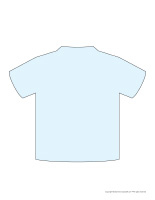
(Open memory game - colors) Print, laminate, and cut out the colored cards. Arrange the cards face down in rows. The first player turns over two cards. If they match, the player keeps them and plays again. If they do not match, they are turned over and it is the next player's turn. Make sure that all players have a chance to see the cards turned over by others. The object of the game is to find as many pairs as possible. The winner is the player with the most pairs.
Colored dominoes
(Open colored dominoes) Print, glue the pieces onto cardboard, and laminate before cutting out. This game is for 2 to 4 players. Each player picks five cards. Make a pile with the remaining cards on the table. Place one card to begin. The first player then attempts to match one of his cards to the initial card. The second player does the same and so on. If a player cannot play one of his cards, he must pick an additional one from the pile. If this card cannot be played either, it is the next player's turn. The game ends as soon as one player has emptied his hands.
Color hunt
Hide colored cards in the daycare. Show children an example of what they are searching for. Have them collect the cards one color at a time. For example, "Bring me all the blue cards." Then, "Bring me all the red cards."
Colored bubbles
Add food coloring to bubble solution and blow colorful bubbles.
Special cleanup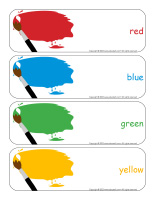
Have children sort the toys by color (example, red cars, blue blocks, etc.)
Colorful ice cube trays
Add a few drops of food coloring in the water and freeze. You can also insert small colorful plastic objects. Prepare several different colors. Place a plastic bin on a large towel. Add all the ice cubes and allow children to enjoy manipulating them.
Colors in the snow
Purchase small spray bottles. Fill with water and powdered paint. Go outside and have children spray on the snow.
Crazy race
Place different colored pieces of construction paper on the floor. These are references for the children. Upon your signal, they have two minutes to gather objects of the color you request and place them on the piece of paper of the corresponding color.
Colored sand
Provide children with bins filled with various colors of sand. Add pastry cutters. Children will enjoy making shapes in the sand.
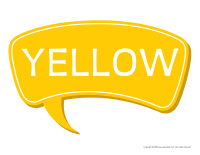
Color associations
Hand out colorful bags (gift bags are ideal). Invite children to fill their bags with objects of the same color by walking around the daycare. To make this more difficult, you may use bags with two colors.
The shaking box
Use an empty egg carton. Write the numbers 1, 2, and 3, three times each in different sections of the egg carton. Color each of the remaining sections with a different color. Children place a button in the egg carton and close it. They shake the box before opening it to see in which section the button landed. They must name the color or the number of the section.
Red light, green light
Prepare round green, yellow, and red cards to represent street lights. Children walk around the daycare. Show the green card and say "Green light." Children must walk faster without running. Show the yellow card and say "Yellow light." Children must walk slowly. Display the red card and say "Red light." Children must stop and remain still. Alternate the different colors.
COGNITIVE ACTIVITIES
Photo booth – Colors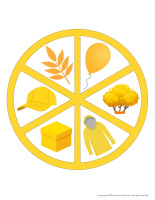
(Open photo booth-Colors) Print the different accessories, cut them out, and press them on drinking straws. Purchase dollar store hats, headbands, scarves, eyeglasses, etc. to complete your photo booth kit. Prepare a corner of your daycare by hanging a large piece of cardboard, a curtain, or a homemade décor and have fun taking pictures of the children in your group. Simply encourage them to pick the accessories they prefer and have fun! Why not invite parents to participate? Take individual or group pictures. They will represent great souvenirs. Print the pictures and use them to decorate your cloakroom walls or hallways.
Spinners-Colors
(Open spinners-Colors) Print and laminate. Cut out the circles and assemble the spinners by associating the colors. Insert a fastener in the center of each spinner.
Children turn the top of each spinner to discover objects of the corresponding color.
Roll and color-3D-Colors
(Open roll and color-3D-Colors) Print a picture for each child. Print and assemble a die. Children take turns rolling the die and coloring part of their picture, per the number shown on the die. The first child to completely color his picture wins.
My colorful chart
(Open my colorful chart) Print for each child. Use this chart daily to encourage children to learn to recognize colors. Invite them to color a box every time they learn to identify a new color. At the end of the week, use the charts to review the names of the colors you explored.
Counting cards – Colors
(Open counting cards-Colors) Print and laminate. Prepare a series of wooden clothespins on which you can paint or draw numbers 1 to 9. Children count the items on each card and place the corresponding clothespin on the correct number.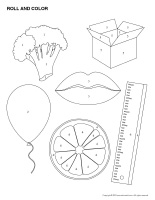
I am learning to count – Colors
(Open I am learning to count-Colors) Print, laminate, and display at children’s eye level. Using Velcro, children associate the correct number of ice cream scoops to each number.
The color wheel
(Open color wheel) Print and cut out the various pieces. Press the color wheel in a paper plate. Cut a tiny hole in the center and insert a fastener to hold the arrows in place. Use the color wheel with your group. Use the 2 smaller arrows to indicate 2 primary colors. Use the larger arrow to indicate the corresponding secondary color. Invite children to explore the color combinations shown on the wheel using poster paint.
Educ-association-Colors
(Open educ-association-Colors) Print the different pages. Glue the first 2 pages inside a file folder. Laminate and cut out the cards containing paint cans. Children must associate each paint can to the paintbrush with the same color of paint and set the card in the appropriate square.
Educ-math-Colors
(Open educ-math-Colors) Print and laminate for durable, eco-friendly use. Children must count the items in each rectangle and circle the correct number.
Musical colors
Give children three different colored crayons (red, yellow, and green) and paper. Select music with a variety of rhythms (fast, medium, slow). Children must draw with the color which best represents the rhythm of the music (green for fast, yellow for medium, and red for slow).
MORAL AND SOCIAL ACTIVITIES
Single color days
Organize several single color days throughout the theme. Ask children to wear clothing items of the chosen color, serve food items of the chosen color, etc. If you wish, combine color days with other activities. For example, you could plan a yellow day on the same day as a corn roast.
Problem-solving rainbow
(Open problem solving rainbow) Print the tool. Use the rainbow whenever a conflict arises between two children. Follow the steps to help children find a win-win solution.
EARLY SCIENCE
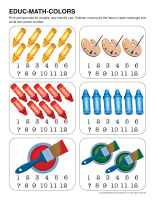
(Open color combinations) Print and laminate. Place it in full view for the children. Present them with glasses of water, food coloring and small spoons. They use the material to create colors through various combinations.
Make a rainbow using a flashlight, water, and a mirror. Plunge the mirror into the water. Light the limit between the water and the mirror with the flashlight and search for the image of a rainbow with a sheet of paper. Observe the decomposition of the light on the paper.
Colored rice or pasta bin
(To be prepared by an adult) Not for consumption.
Ingredients:
1 pint of uncooked pasta or rice
2 tablespoons of food coloring
3 tablespoons of rubbing alcohol
Combine the food coloring and the rubbing alcohol in a container. Add the pasta or rice and close the container. Gently shake it. Be sure to cover all the pasta or rice with color. Spread the pasta or rice in a single layer on a baking sheet and let dry for several hours.
Arrange the pasta or rice in bins by color or in one multicolored bin. Children will have fun with figurines or pouring the pasta or rice in various containers.
Colored celery
Place in colored water a branch of celery with its leaves. The leaves will turn the same color as the water.
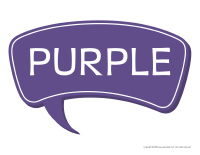
CULINARY ACTIVITIES
Colorful lunch
Throughout the week, add a few drops of food coloring to various foods
(ex. Shepherd's pie with blue potatoes, green milk, pink vanilla pudding, etc.)
Paint recipe
Combine corn syrup with food coloring.
ARTS & CRAFTS
The rainbow (group project)
Draw a rainbow on a large piece of cardboard. Cut out small pieces of construction paper for all the colors of the rainbow. Children glue the pieces of paper in the correct arch of the rainbow (depending on the color).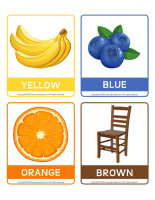
Mixed colors
Children paint freely. The goal is to create new colors by mixing them.
Colors of the rainbow
Use tactile paper. Children color with waxed crayons using colors which can be found in rainbows. Have them paint over the crayon with black paint. Allow to dry completely. Once dry, children trace over the black paint to discover the rainbow colors beneath.
Paint bubbles
Add a few drops of food coloring to prepared bubble solution. Children create a bubble blower with a pipe cleaner. Provide them with a sheet of white paper and have them blow bubbles onto it. This will create a beautiful pastel picture.
Colorful world
Children paint or color two toilet paper rolls the color of their choice. Make binoculars by gluing them together. Punch two small holes on either side and insert a cord. Add cellophane paper to the ends. Children will see everything in color! They may keep them around their necks.
COLORING PAGES
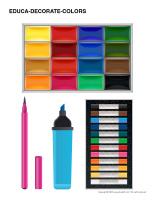
(Open coloring pages theme-Colors) Print for each child.
SEQUENTIAL STORY
(Open sequential story - colors) Print, laminate and cut out.
Children must place the story in the correct order.
SONGS & RHYMES
Rainbow, rainbow
By: Patricia Morrison
Sung to: Twinkle, twinkle little star
Rainbow, rainbow in the sky
How I love your colors so bright
Blue and yellow, green between
Orange and red are also seen
Rainbow, rainbow in the sky
How I love your colors so bright
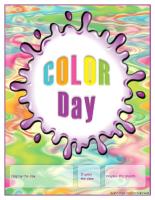
Baa Baa black sheep
Have you any wool
Yes sir, yes sir
Three bags full
Repeat with other colors absent in the rainbow song such as white, gray, brown, etc.
SPECIAL DAY
We suggest organizing a special day during the color theme week using one of the suggestions below.
Special Color Day (Open perpetual calendar - color day)
Greeting: Children must bring something of their favorite color from home. You may also decide to have a green day or a red day....
Circle time: Discussion about colors. Children name their favorite colors.
Lunch and snacks: Plates filled with colorful fruits and vegetables, food coloring in milk, etc.
Special activity: Activities with modeling clay, science experiment with food coloring or paint,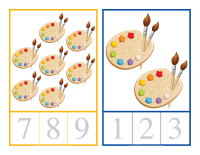
color combinations...
Black & White Day (Open perpetual calendar-black and white day)
Greeting: Children come dressed in black and/or white. Greet them with a white (Santa) or black (witch) wig.
Circle time: Use makeup to paint children's faces black and white like pandas.
Lunch and snacks: Play a guessing game. Place salt and pepper shakers on the table. Children must guess which is which. Children can search for black and white in their plates.
Special activity: Paint children's faces black and white. Have fun finding black and white objects in the daycare. Mix black and white paint. Draw with white chalk on a black piece of cardboard.
Have a great week!
Have fun!
The Educatall team
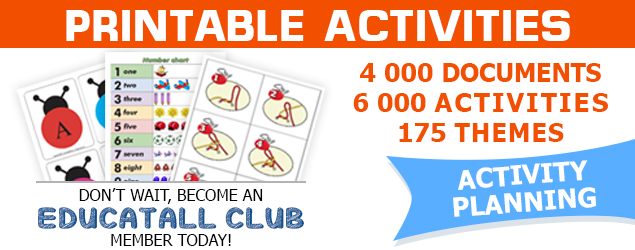
 Home
Home Theme activities
Theme activities
 Babies and toddlers
Babies and toddlers
 Arts and crafts
Arts and crafts
 Science
Science
 Creative recipes
Creative recipes
 Tips and tricks
Tips and tricks
 Special needs
Special needs
 Extra activities
Extra activities
 Educ-TV
Educ-TV
 Newsletter
Newsletter  Online store
Online store Educatall club
Educatall club

